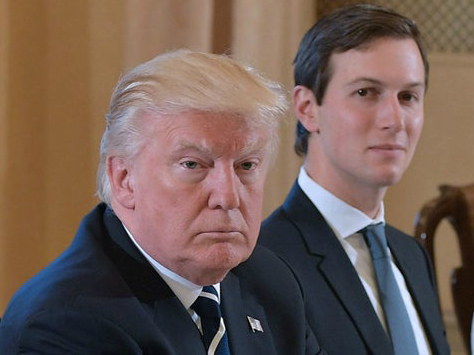Four Missing Components from Kushner’s Merit-Based Immigration Reform
 President Trump recently released another plan to reform the immigration system. The latest plan was drafted with the help of his son-in-law and presidential advisor Jared Kushner. Overall, this last plan is the best of those proposed so far as it reduces legal immigration the least, as my colleague David Bier ably explains. Kushner’s impact on President Trump’s thinking on immigration, as on the area of criminal justice reform, has been extremely positive and I hope that his advising role continues to expand. The fundamental idea of merit-based immigration reform is sound: There should be more economic immigrants admitted to the United States. Still, there are at least four additions to the Kushner plan that would make an enormously positive difference in the final policy.
President Trump recently released another plan to reform the immigration system. The latest plan was drafted with the help of his son-in-law and presidential advisor Jared Kushner. Overall, this last plan is the best of those proposed so far as it reduces legal immigration the least, as my colleague David Bier ably explains. Kushner’s impact on President Trump’s thinking on immigration, as on the area of criminal justice reform, has been extremely positive and I hope that his advising role continues to expand. The fundamental idea of merit-based immigration reform is sound: There should be more economic immigrants admitted to the United States. Still, there are at least four additions to the Kushner plan that would make an enormously positive difference in the final policy.
The following four points are reforms that should have been included in the Kushner plan that would transform the U.S. immigration system into one that emphasizes economic and merit-based immigration without reducing family-based immigration. Regardless of any other legal changes, the following four reform suggestions would be positive on their own.
1. Reform employment-based green cards by exempting immediate relatives, exempting adjustments of status, and ending the per-country limits from the numerical quota. Exempting children and spouses from the employment-based green card quotas would immediately increase the number of green cards for skilled workers by over 60,000 annually, based on the 2017 numbers. Even better, Congress should exempt adjustments of status from the green card quota as 82 percent of them were already living here legally on another visa before earning their employment-based green cards. At a minimum, this would increase the number of employment-based green cards issued annually by over 100,000 and possibly by far more. Lastly, ending the per-country limits would reduce unjust discrimination against immigrants from populous countries. While ending the per-country limits would not increase merit-based immigration on its own, exempting family-members and adjustments of status would achieve a similar benefit for those in the backlog while boosting the number of employment-based green cards annually.
2. The Kushner plan should have endorsed the state-based visa reform programthat was introduced last Congress by Senator Ron Johnson (R-WI). Senator Johnson’s bill was inspired by the Canadian Provincial Nominee Program (PNP) that is the second largest source of economic immigrants to Canada. Johnson’s state-based visa program would issue 500,000 non-immigrant visas annually divided among the states by population with each state guaranteed at least 5,000 annually. Unlike other visas, state-based visas would be mostly regulated by state governments that would determine the economic criteria for selecting migrants. Rather than be constrained by the visa categories that the federal government believes are the best, states would be allowed to experiment by creating visas for entrepreneurs, investors, or workers of any skill or type. Crucially, states would not have to participate in the state-based visa program if they don’t want to and the number of visas would automatically grow in states that follow the rules and shrink in those that don’t. Please check out Senator Johnson’s billand David Bier’s wonderful paper about it.
3. The third proposal that would have boosted the merit of Kushner’s plan is the immigration tariff. Heavily influenced by the late Nobel Prize-winning economist Gary Becker, an immigration tariff would sell non-immigrant permanent resident visas called a gold card. The numerical quantity of visas would not be limited in law, but the high prices for each visa would act as a de facto numerical limit on the number issued. As I proposed in a mock tariff schedule, Congress could set the price for visas based on the age and education of the migrant whereby younger and better-educated migrants pay a lower price than older less educated migrants. The price of the visa offers some labor market protection to American workers but is also flexible enough that more migrants will purchase the gold card when the U.S. economy is expanding and fewer will do so when the economy is shrinking. Furthermore, those willing to pay high prices for a visa will be extra motivated to succeed here and they will also be more likely to believe that they have the abilities to do so. The money raised through this tariff, which I estimate here, would be more than enough to cover the cost of the surge of asylum seekers along the southern border and provide additional resources for border security – although I prefer to use the funds to finance a tax cut for lower-skilled Americans. There are many other proposals in this vein, such as the IDEAL visa, that the administration should also consider to boost merit-based migration.
4. Do not cut the number of immigrants. The Kushner plan does cut the number of new immigrants who will arrive in the United States annually even though it keeps the number of green cards the same. The Kushner plan transfers family-sponsored preference green cards and diversity green cards to the employment-based green card categories. Ninety-four percent of the immigrants who received a family-sponsored preference green card and 98 percent of those who received a diversity green card were new arrivals while the rest adjusted their statuses from other visas. Meanwhile, eighty-two percent of employment-based green cards went to migrants who were already legally working and living in the United States – mostly on H-1B visas. In other words, the Kushner plan trades new immigrant arrivals in the family and diversity green card categories for green cards in the employment-based green card categories that will go to workers who are mostly already in the United States. Don’t get me wrong – green cards are better than H-1B visas as workers are more productive, have more flexibility, and make longer-term investments in their new home when on green cards as opposed to the temporary H-1B visa, but trading new immigrants for improving the economic prospects of existing migrants is a bad deal. Although the number of green cards remains the same under the Kushner plan, the number of new immigrants arriving in the United States will decrease across all visa categories.
Many meritorious immigrants to the United States do not enter on economic visas but come in on family-based green cards and the diversity visa. In the same way that Americans can be family members and workers, many immigrants enter the United States on family-based green cards also intend to work. Over time, they are also becoming more skilled. The share of admitted immigrants who have at least a college education increased from 22 to 39 percent from 1993 to 2015. Over the same period, the share of admitted immigrants who are high school dropouts decreased from 37 percent to 27 percent. Since so few new immigrants to the United States are on employment-based green cards, much of the increase in education must come from family-based immigrants and those on the diversity visa.
Setting the number of legal immigrants is not like setting a budget that needs to be balanced over the long term. There is no deficit here. Increasing the number of explicit economic or merit-based immigrants does not mean that the number of family-based green cards needs to be cut. It’s wonderful that the president seems to have moved away from his previous position that the number of green cards needs to be reduced and we can thank Mr. Kushner’s hard work for that, but the government can increase the number of economic and merit-based immigrants without changing any other portion of the immigration system. If President Trump wants to be known for shifting America toward a more merit-based immigration system, boosting the number of economic immigrants without cutting family immigration is the path of least resistance and greatest gain.








